The Inner Bridges
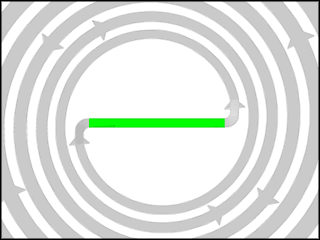
An inner bridge connects the inner end of one spiral arm with the inner end of a second spiral arm. Below the central balance point, the inner bridge connects to the low end of the spirals arms (disc and swirl). Above the central balance point, the inner bridge connects to the high end of the spirals arms (revolute and scroll ring). This is the exact opposite of that of the outer bridges. But like the outer bridges, these bridges also start and end at the same level of dimensionality. In between these ends the vortex movement changes from inward to outward or from outward to inward (movement of the vortex, not the wave). This is because the movement of the bridge starts at the end of an inward flowing spiral arm, and ends at the start of an outward flowing spiral arm.
Another difference with the outer bridges is that those bridges are never seen without the spirals (except when the equilibrium of the medium is the same as the spirals), but inner bridges are most often seen without the spirals. This makes them a bit harder to identify.
Five different inner bridges are believed to exist within the first half-cycle, the monolith, the helibar, the endobar, the laminar belt and the omega bridge. Three of these have already been observed and have been confirmed to exist, but two of them, the monolith and the omega bridge, have not been determined to exist. Why the monolith is believed to exist is explained on the page about state of equilibrium. Why the omega bridge is believed to exist is explained on this page.
Monolith

| Classification | First inner bridge of the first cycle |
| Dimension | 0.75D (inward to outward) |
| Positive / Negative | Positive |
| Core | Yes |
| Periphery | No |
| Rotational sum movement | No |
| Minimum number of movements | 1 |
| States of equilibrium |
Inorganic: Rock Organic: Unknown |
| Origin of the name | Mono because the lowest possible number of movements for this vortex is one. A monolith is an upright block of stone most often shaped like a pillar, which is a reference to its state of equilibrium |
The vortex that connects the inner end of an inward flowing spiral arm of a disc spiral with the inner end of an outward flowing spiral arm of that same disc spiral, revealing the presence of a wave with a single constant dimensionality of 0.75D, is called the monolith. The monolith is nothing more than a single movement in a straight line, with no acceleration or deceleration, and it is a non-rotational vortex. The shape of the vortex, when highmorphed, is that of a thin shaft with equal thickness at both ends. When the vortex is unmorphed, thus not a highmorph or lowmorph, then it does not have any thickness at all and can not be seen with the naked eye. This is because the monolith only has a core movement and no periphery. When the monolith upmorphs into a helibar, it grows itself a periphery and thus becomes visible. I chose to illustrate the monolith as a highmorph monolith instead of only drawing a straight core line so you can get a better understanding of what a monolith is.
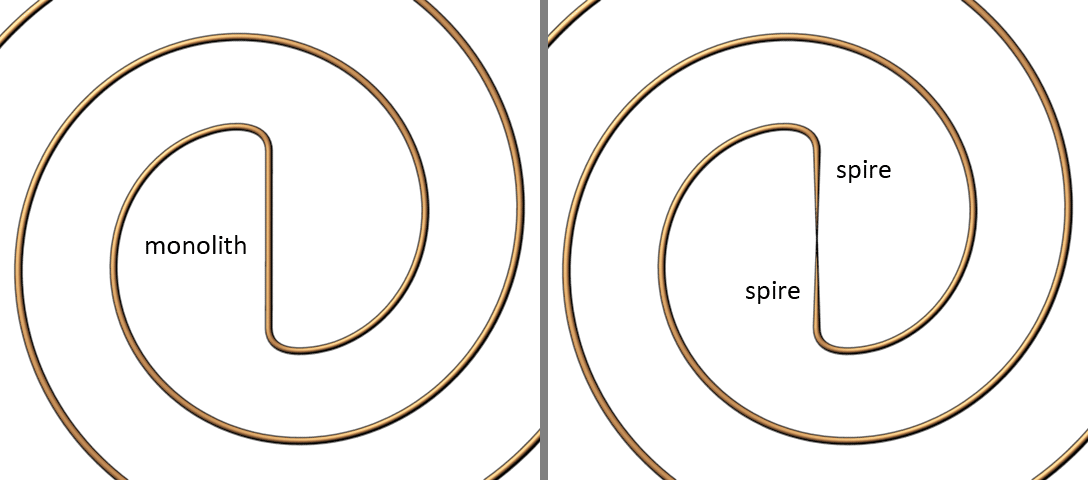
The picture above shows how a monolith is positioned deep within a disc spiral when connected in a sequence. The monolith should be the low dimensional (yang) antipode of the omega bridge. One lies 4,5 dimension levels above the central balance point, the other lies 4,5 dimension levels below the central balance point. The monolith is one of the two inner bridges that is believed to exist but has not yet been found yet. There aren't any examples yet of this vortex. But there is at least one human invention that strongly suggest that this vortex exists, and that's a double spiral amplifier developed by NASA, shown below.
Double spiral amplifier
Researchers at NASA's Jet Propulsion Laboratory and the California Institute of Technology, both in Pasadena, have developed a new type of amplifier for boosting electrical signals. The device can be used for everything from studying stars, galaxies and black holes to exploring the quantum world and developing quantum computers.
An amplifier is a device that increases the strength of a weak signal. One of the key features of the new amplifier is that it incorporates superconductors-materials that allow an electric current to flow with zero resistance when lowered to certain temperatures.
Although the amplifier has a host of potential applications, the reason the researchers built the device was to help them study the universe. The team built the instrument to boost microwave signals, but the new design can be used to build amplifiers that help astronomers observe in a wide range of wavelengths, from radio waves to X-rays.
More about the amplifier can be read by clicking on the image above
The two turns at the center of the spiral are excessively large. But there is a bridge at the center of that spiral that connects the two spiral arms. Because there is a current running through the wire from the left position in the photo to the right position in the photo, spiraling inward, then outward, we know that the movement within the bridge must also be in one direction, and not in two directions as is the case with the outer bridges.
Helibar

| Classification | Second inner bridge of the first cycle |
| Dimension | 1.75D (inward to outward) |
| Positive / Negative | Positive |
| Core | Yes |
| Periphery | Yes |
| Rotational sum movement | Yes |
| Minimum number of movements | 1 + 1 |
| States of equilibrium |
Inorganic: Earth Organic: Unknown |
| Origin of the name | Heli because of its rotational helical movement. Bar because of its elongated bar shape |
The vortex that connects the inner end of an inward flowing spiral arm of a swirl spiral with the inner end of an outward flowing spiral arm of that same swirl spiral, revealing the presence of a wave with a single constant dimensionality of 1.75D, is called the helibar. The shape of the vortex is that of a solid helix, with one straight line as its core and one rotational movement around the core (with solid I do not mean solid state of matter. What I mean is that the vortex, whether it exist in a gas, liquid or solid form, is not hollow). The helibar is therefore recognized as being a rotational vortex. In the example above I deliberately drew a helibar with thick windings. This is only to illustrate that it has a helical movement. In real helibars the windings are finer and less evident and the shape is more like that of a smooth cylinder, but the rotation around the core is detectable if one can observe the movement. The helibar is the low dimensional antipode of the laminar belt. One lies 2,5 dimension levels below the central balance point, the other lies 2,5 dimension levels above the central balance point.

The helibar and helicone are two vortices that are close in similarity. The helibar is like a weaker version of the helicone (with weaker I mean less powerful contraction). It is slower in movement and does not pull as hard on objects in its vicinity compared to a helicone. The helibar is also twice as long as the helicone. For a very long time I mistook the helibar for a helicone. I thought that the helibar was simply a helicone that was out of shape, because of it not being conical. At that time I only knew about the existence of the outer bridges, I still had not understood the existence of the inner bridges. It was only when I understood the existence of the inner bridges that I found out that they are both different vortices.
![]()
Five examples of helibars are the central bar in NGC2146 (macrocyclic), waterspouts (mesocyclic), deep water tornadoes (mesocyclic), the vortex made by a tornado generator (mesocyclic) and steam devils (mesocyclic).
Central Bar in NGC2146
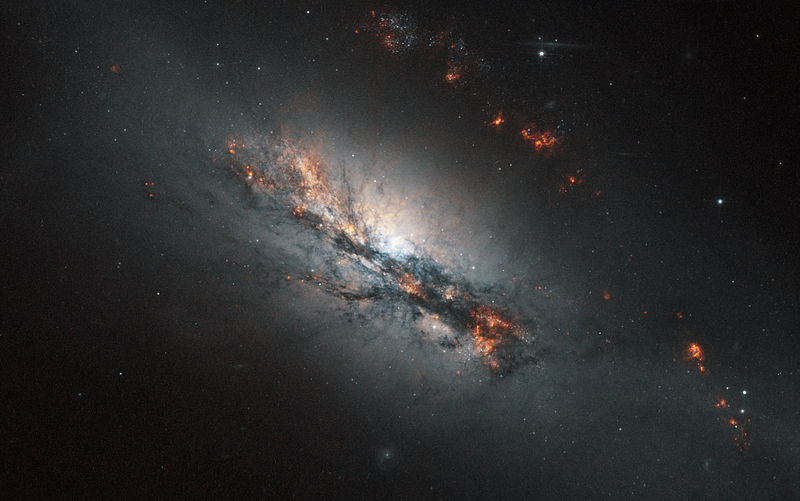
Image by ESA/Hubble & NASA, under CC BY 3.0 license
Most spiral galaxy bars consist of two helicones with a disc spiral at the center, but the spiral bar can also take the form of a helicone. Above is one such example. It is an image of NGC2146.
The dense white glow around the helibar is a bulb. This is because the spiral galaxy (double swirl), is slowly morphing into a double bulb. That is why the spiral arms are shortening and disappearing. Logically, at the same time, the helibar should be morphing into an endobar. Because the swirl has morphed upwards in the sequence, and because the helibar and much of the galaxy looks distorted, it is not the best example as I hoped to find. But it is the only example of a helibar in outer space that I found.
Waterspout
_PublicDomain.jpg)
Image by Dr Joseph Golden, NOAA
A waterspout is like a tornado over water. It is usually weaker than a land tornado and its shape is more cylindrical and not conical. Most waterspouts are also longer than land tornadoes.
These waterspouts are helibars, while most land tornadoes are helicones. The reason why helibars form over water and helicones form over land is explained on the page about state of equilibrium.
It took quite a while for me to figure out what exactly a waterspout is. It was not that easy because a waterspout and a tornado are in most cases not seen with a connection to the spiral arms. They only appear as single vortices. The air at the upper end of the vortex must be as low dimensional as the low end of a swirl, which is 1.75D. Normally, air is balanced around the center of the bulb, somewhere around 3.0D (the bulb is the state of equilibrium for air). There must be special weather conditions that make the air or clouds temporarily lower dimensional and thus permit these tornadoes to form.
Subaquatic Water Tornado
With 'subaquatic' I mean that the vortex is not touching the water surface but is located at least a bit deeper down. When you see a tornado-like vortex underwater that starts at the water surface, then that vortex is most likely a whirlpit (see page about the tunnels). But both helicones and helibars can also appear underwater. Below is a video that shows an example of a helibar on the bottom of (not so deep) ocean waters.
A difference between this vortex and a whirlpit is that the whirlpit is hollow, it is an air-core vortex. The subaquatic water tornado is not. There is no air inside the vortex, instead it is made of a spinning water mass that has a different density than the water around it.
Tornado Generator

Image by Jeff Kubina, under CC BY-SA 2.0 license
This machine is called a tornado machine, or tornado generator, but the vortex is not like a tornado but like a waterspout. Thus the vortex created by this machine is not a helicone but a helibar. Tornado generators are a useful tool for studying these vortices. A difference with the waterspouts is that these vortices move faster, because they are smaller. Smaller size is lower dimensional, thus time runs faster.
Steam Devil
A steam devil is a small, rotating air vortex over water that is relatively warm compared to the colder air above the water surface. The rotating air becomes visible when fog is drawn into the vortex. Steam devils are like a smaller version of waterspouts that form over large lakes or oceans under dissimilar conditions.
Endobar
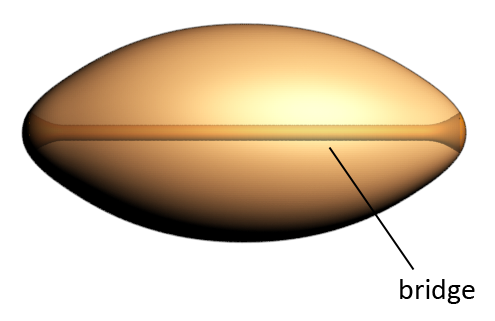
| Classification | Third inner bridge of the first cycle |
| Dimension | 2.75D |
| Positive / Negative | Positive |
| Core | Yes |
| Periphery | Yes |
| Rotational sum movement | No |
| Minimum number of movements | 1 + 7 (estimate) |
| States of equilibrium |
Inorganic: Unknown Organic: Unknown |
| Origin of the name | Endo because it is an internal bridge, in contrast to the exobar. Bar because of its elongated bar shape |
The vortex that connects the inner end of an inward flowing spiral arm of a double bulb with the inner end of an outward flowing spiral arm of that same bulb, revealing the presence of a wave with a single constant dimensionality of 2.75D, is called the endobar. The only deviation here from the other inner bridges is that the spiral arms of the double bulb are not visible. The shape of the bridge vortex is that of a long cilinder which is oriented along the central axis of the bulb and has a different density than the vortex around it. It is a non-rotational vortex. The endobar is the low dimensional antipode of the exobar. One lies half a dimension level below the central balance point, the other lies half a dimension level above the central balance point.

The endobar and exobar are two vortices that show a lot of similarity in shape. If the bulb or bulbs are not attached to them then at this point I would not know how to tell which one is which, this is because there haven't been enough observations of these vortices to know enough information to know the difference. I expect the exobar to be thicker. Both do not have a rotation in their movement, but the movement of the vortex does start and end in a different location. For the endobar the movement goes from one end to the other. For the exobar the movement starts at the center and goes into two opposite directions simultaneously.
Two examples that shows the endobar is the galaxy UGC 9618 (macrocyclic) and a droplet in a cotton candy (mesocyclic).
Galaxy UGC 9618
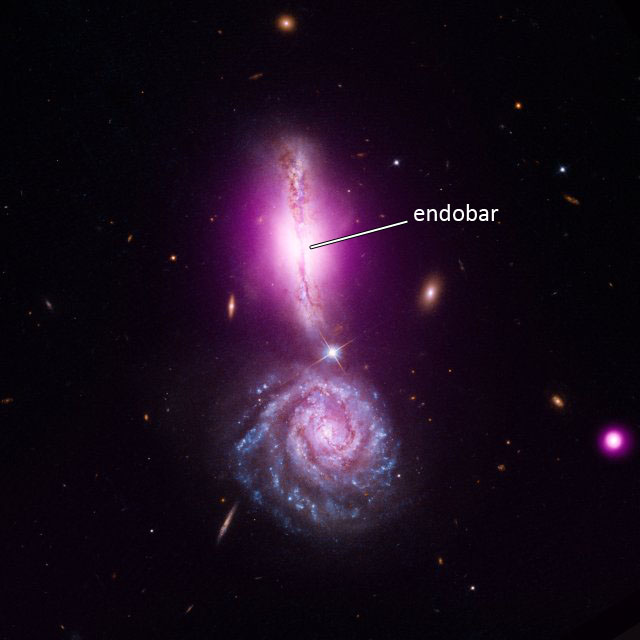
Image by Smithsonian Institution / NASA. Image was edited with
text and line
UGC 9618 is a galaxy in the constellation Boӧtes. It consists of a binary swirl spiral of which one of the two spirals has morphed almost completely into a bulb. The bulb has an inner bridge, an endobar, running through its central axis.
Droplet in a Cotton Candy
A cotton candy is made up of a huge number of tiny threads. If a drop of water is added to the cotton candy then a part of the cotton candy dissolves while the droplet propagates within the threads of the cotton candy. The image below shows how the droplet moves within the threads.
 |
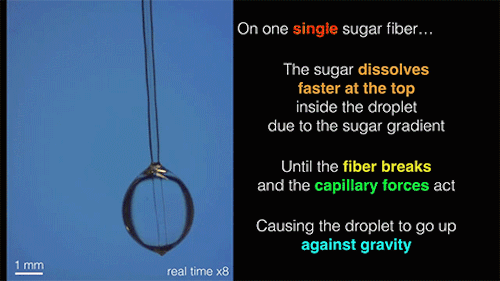 |
Both images By Stéphane Dorbolo Under Creative Commons Attribution License. Images were edited.
A droplet is a bulb. The droplet absorbs a piece of thread and that thread then becomes the endobar of the droplet. A cotton candy is sticky, which is a common characteristic of a bridge vortex. The reason that the endobars are short lived in this example might be because the droplet is a single bulb and thus not a double bulb (which is more elongated in shape), which is required for an endobar.
Laminar Belt

| Classification | Fourth inner bridge of the first cycle |
| Dimension | 4.25D (inward to outward) |
| Positive / Negative | Positive |
| Core | No |
| Periphery | Yes |
| Rotational sum movement | No |
| Minimum number of movements | 21 (estimate) |
| States of equilibrium |
Inorganic: Unknown Organic: Unsaturated Fat |
| Origin of the name | Laminar because pie sections of this vortex are what induces laminar flow |
The vortex that connects the inner end of an inward flowing spiral arm of a revolute spiral with the inner end of an outward flowing spiral arm of that same revolute spiral, revealing the presence of a wave with a single constant dimensionality of 4.25D, is called the laminar belt. The shape of the vortex is that of a flat annular ring. The laminar belt is the high dimensional (yin) antipode of the helibar. One lies 2,5 dimension levels above the central balance point, the other lies 2,5 dimension levels below the central balance point. The laminar belt is a non-rotational vortex.
The picture below shows how a laminar belt is positioned deep within a revolute when connected in a sequence. This is one of the connections that has not been observed yet. I still haven't seen a laminar belt deep within a revolute. But you will need to read all the pages on this website to understand that the image below most likely gives a correct picture of how the laminar belt is positioned between its adjacent vortices when connected in a sequence. The inner end of the revolute is the position where the laminar belt belongs in the transformation sequence.

The laminar belt is close in similarity to the aureole belt. The laminar belt is like a weaker version of the aureole belt (with weaker I mean less powerful expansion), its dimensionality lies closer to that of the central balance point, where the sum of contraction and expansion is zero. The laminar belt is twice as wide as the aureole belt and has equal thickness at both the inner and outer radius. The aureole belt has a slightly conical cross-section, and thus has a different thickness at start and end.
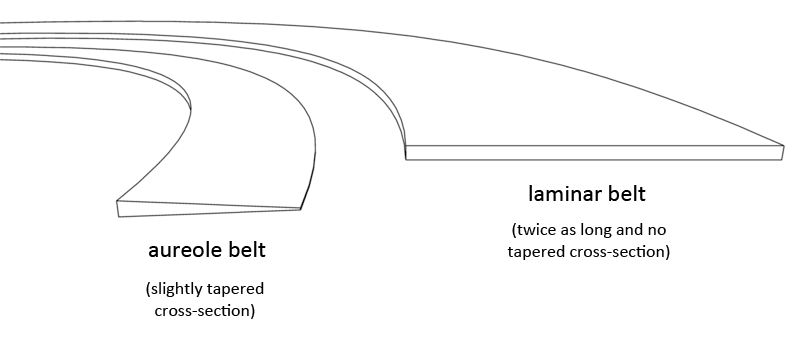
So far, I have found only one source where full circular laminar belts can be observed, and that is at nuclear detonations as condensation clouds (mesocyclic).
Condensation Clouds

Above is a photo of a large nuclear detonation that shows one single belt. It is from a British nuclear detonation Grapple-X Round A, in which the detonation took place higher up in the atmosphere instead of at ground level. This one shows the shape of the laminar belt very clearly. We know that this is a laminar belt because of its width.
But, according to the theory presented here, the laminar belt is supposed to appear within the revolute, not outside the revolute. The revolute is present here too. It is the head of the mushroom cloud. So the belt does appear at the location of the revolute but not inside the revolute, and with a much larger size. Also, this belt vortex is continuously morphing, while the revolute doesn't appear to morph, or morphs only a little at the start of the explosion.
I do not have an explanation for why this happens. It could be that there are two directions in which the sequence can go to, instead of continuing in one direction. In that case both directions show great similarities in the shape of the vortices. It also could be that the next vortex in the sequence must always be larger than the previous, which is a characteristic which we also observe in the morph sequence. This could be caused by the redshift of our universe around us, and could be a limitation which does not apply to other locations in the universe, but does apply here on earth.
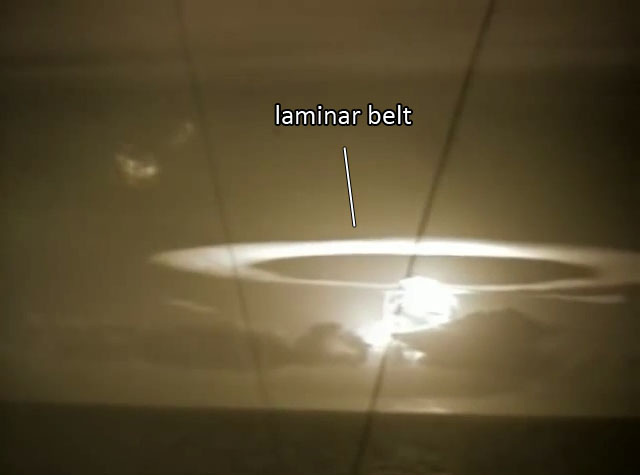
Operation Redwing, Bikini Atoll. Screenshot taken from movie from the
National Archives
Some of these condensation clouds that appear at nuclear detonations are laminar belts, others are aureole belts. Sometimes you see an explosion that first spawns one or more aureole belts, and some seconds later one or more laminar belts. The aureole belts appear first because those vortices are stronger and only appear when the force of the explosion still is the strongest. They are also often seen more higher in the sky then the laminar belts. Some explosions show both types of belts simultaneously, in that case the aureole belts form the upper rings and the laminar belts form the lower rings. The reason for this is that the air at higher altitudes is higher dimensional.
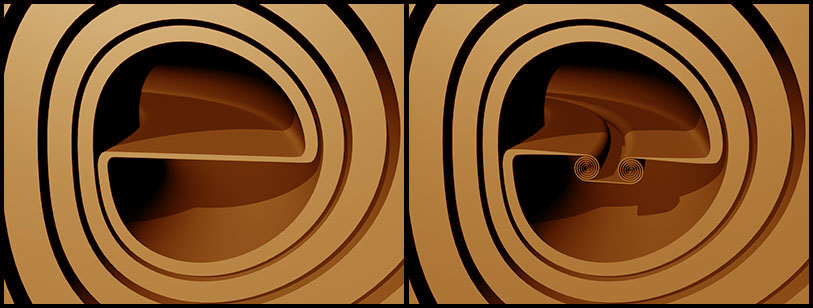
One way to determine if a condensation cloud is an aureole belt or a laminar belt is by looking at its width, by which I mean the distance from inner radius to outer radius. The second method to differentiate these two vortex types is by looking at how they morph. The aureole belt bends into an arc when it morphs into the next ladder in the sequence, which is the omega ladder. The laminar belt remains flat while morphing (which reveals that it does not morph into an omega bridge).
Omega Bridge

| Classification | Fifth inner bridge of the first cycle |
| Dimension | 5.25D (inward to outward) |
| Positive / Negative | Positive |
| Core | No |
| Periphery | Yes |
| Rotational sum movement | No |
| Minimum number of movements | 55 (estimate) |
| States of equilibrium |
Inorganic: Unknown Organic: Unknown |
| Origin of the name | The greek letter Omega means 'great O', refering to it being one of the highest dimensional vortices in the first cycle and its ring shape. Bridge because this vortex is a bridge type vortex |
The vortex that connects the inner end of an inward flowing spiral arm of a scroll ring with the inner end of an outward flowing spiral arm of that same scroll ring, revealing the presence of a wave with a single constant dimensionality of 5.25D, is called the omega bridge. The shape of the vortex is that of a very short cylinder, so short that it looks like no more than a thin ring. Its shape is close to that of an omega ladder. The difference is that a has a triangular cross-section, getting narrower as it approaches the infinity ring. The omega bridge is also twice as long than the omega ladder and has a rectangular cross-section, thus with equal thickness from start to end. The omega bridge is the high dimensional antipode of the monolith. One lies 4,5 dimensions above the central balance point, the other lies 4,5 dimensions below the central balance point. The omega bridge is a non-rotational vortex despite being circular in its shape, its flow movement goes in one direction.
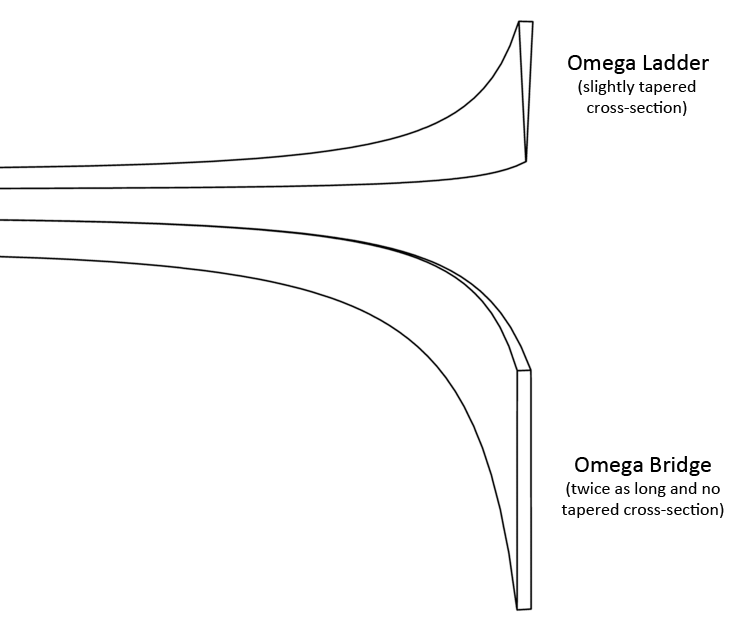
Below you can see a cut-through image of how the omega bridge is positioned at the center of a scroll ring, compared to that of how two opposing omega ladders are positioned at the center of a scroll ring. An omega ladder connects to the infinity ring (with one unknown vortex in between), an omega bridge does not. Because both vortices are very thin I expect it will be hard to determine whether any such vortex observed in our world is an omega bridge or an omega ladder.
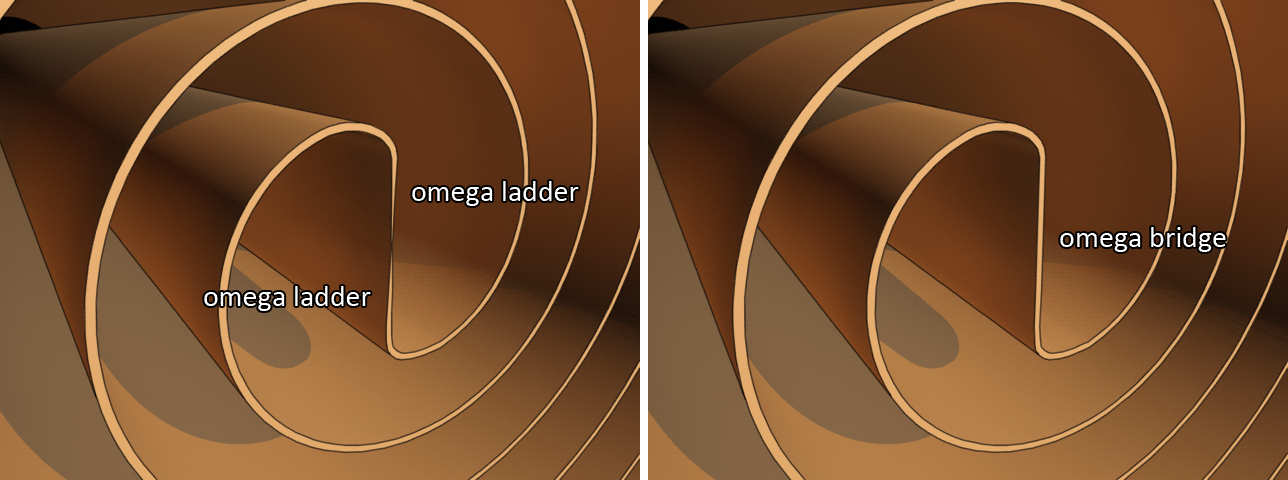
When two opposing omega ladders form within the center of a scroll ring, the direction of flow of both spiral arms is inward, from the low end of the spiral to the high end of the spiral. But when an omega bridge forms at the center of a scroll ring, then the direction of flow in one spiral arm is inward, and the other arm outward.
This again is one of the few vortices which is predicted to exist, but which has not been observed yet. It's existence is determined by the logical order of the transformation sequence and the gaps that appear in the puzzle. This does not proof that the omega bridge exists, it is not 100% sure that it does. One condition on which its existence depends is whether the bulb really is the center of the sequence, and whether the zero point and infinity ring really both share the same distance to that center.
| All content on this site that is authored by Peter.A.Venis is licensed under the Creative Commons CC BY 4.0 license, unless otherwise mentioned. Most pages on this website also include material from other authors, under different licenses. Both the author's names and the licenses are mentioned in the file names whenever this information is known and can be provided. The presence of work from other authors on this website does not necessarily imply that those authors endorse the contents of this website. |
| A word that is often used on this website is the word 'vortex'. Many sources describe a vortex as a movement in a fluid that has a rotational flow. Yet many of the vortices that I describe on this website do not show a visible rotational flow. I took the liberty of using the word vortex for describing a phenomenon that had not been understood before, one that links together rotational and non-rotational movements. Even a movement in a straight line can in some cases be categorized as a vortex, if it is known that that movement is created by certain identical conditions. So keep in mind that the word 'vortex', within the context of the infinity-theory, has not the exact same meaning as other sources describe. |




